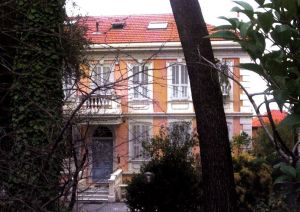A hidden villa
 The villa, located in Corso Cavallotti, also known as Villa Garbarino, was built by the Genoese patrician Giuseppe Garbarino in 1867, above the remains of a small rural building, to a design by engineer Fergola. Consisting of three floors with large attics, the villa also had a terrace that descended towards the beach, where there was a room specially built for bathing.
The villa, located in Corso Cavallotti, also known as Villa Garbarino, was built by the Genoese patrician Giuseppe Garbarino in 1867, above the remains of a small rural building, to a design by engineer Fergola. Consisting of three floors with large attics, the villa also had a terrace that descended towards the beach, where there was a room specially built for bathing.
The large garden, cultivated by the floriculturist Sommariva, also included a grotto with a bathtub and four water wells. The first tenant who stayed in the villa was Lord Russell (1792-1878), several times head of the British government and foreign minister, a convinced supporter of the Italian Risorgimento cause, so much so that he did not fail to support and approve the annexation of central Italy, the expedition of the Thousand and finally the proclamation of the Kingdom of Italy.
In March 1895 the member of the Russian imperial family Aleksej Michajlovic Romanov died there at the age of twenty. He had come to our city to recover from a serious form of consumption and for his funeral the warships Sardinia, Roger of Lauria and Arethusa arrived in the roadstead of Sanremo, The solemn funerals were attended by his brother Sergej Michajlovic, the Grand Duke of Mecklemburg, Dukes Eugene and George of Leuchtenberg, Vice Admiral Frigerio and Duke John the Baptist Borea d'Olmo representing King Umberto I and numerous illustrious personalities from various European states.
During the procession of the hearse towards the railway station, from where the body would leave for St. Petersburg to the sound of the Russian national anthem and the gunfire of the ships, some Russian popes, who had come specially from Cannes, recited the prayers of the rite of Christian Orthodox worship.
Various sovereigns and presidents of European states sent crowns to the ceremony, including the German Emperor William II, the Austro-Hungarian Emperor Franz Joseph, the King of Italy Umberto I and the French President Félix Faure.
The villa, which is characterised by its beautiful forms inspired by art deco, was renovated and transformed into its present appearance in 1931, as a writing on the facade recalls.
(source Andrea Gandolfo)




